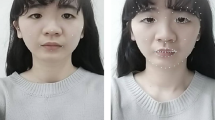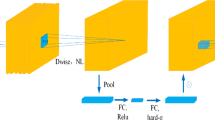Abstract
Acupuncture is a form of alternative medicine from ancient times and adapted to modern medicine. One typical practice of acupuncture is putting pressure on specific sites (acupuncture points, or acupoints) in the body, called acupressure. Self-acupressure refers to people applying pressure on acupoints using fingers, palms, or special devices to themselves. It has been widely applied because of its convenience and effectiveness. However, localizing the acupoints in any acupuncture practice requires expert knowledge. Novices without any medical background typically find it difficult because of the lack of visual cues. Our previous prototype, FaceAtlasAR, stresses this issue by localizing and overlaying facial acupoints in the augmented reality (AR) context in real-time. This paper will present E-FaceAtlasAR, which extends FaceAtlasAR to show auricular zone maps in the meantime. The system first localizes facial acupoints and auricular zone map in an anatomical yet feasible way. Then, it overlays the requested acupoints and auricular zone maps on the ears in AR. We adopt Mediapipe, a cross-platform machine learning framework, to build the real-time pipeline that runs on desktop and Android phones. Also, we conducted extensive experiments to show its effectiveness and robustness. With this system, users, even not professionals, can position the acupoints quickly for their self-acupressure treatments.



























Similar content being viewed by others
Data Availability
The data that support the findings of this study including public datasets AMI dataset and “In-the-wild” dataset, which are available in the public domain. The data citation in the main article has the full URL. Other data are available on request from the corresponding author, M.Z.
References
AACP: Evidence Based Acupuncture Training, Acupuncture in Physiotherapy. The Acupuncture Association of Chartered Physiotherapists (AACP)s. The Acupuncture Association of Chartered Physiotherapists (AACP)s
Artyfactory THE PROPORTIONS OF THE HEAD. https://www.artyfactory.com/portraits/pencil-portraits/proportions-of-a-head.html
Azuma RT (1997) A survey of augmented reality. Presence Teleoperators Virtual Environ 6(4):355–385
Belhumeur PN, Jacobs DW, Kriegman DJ, Kumar N (2013) Localizing parts of faces using a consensus of exemplars. IEEE Trans Pattern Analy Mac Intell 35(12):2930–2940
Berman BM, Lao L, Langenberg P, Lee WL, Gilpin AM, Hochberg MC (2004) Effectiveness of acupuncture as adjunctive therapy in osteoarthritis of the knee: a randomized, controlled trial. Ann Intern Med 141(12):901–910
Bulat A, Tzimiropoulos G (2017) How far are we from solving the 2d & 3d face alignment problem?(and a dataset of 230,000 3d facial landmarks). In: Proceedings of the IEEE International Conference on Computer Vision, pp. 1021–1030
Chen Y-Z, Maigre C, Hu M-C, Lan K-c (2017) Localization of acupoints using augmented reality. In: Proceedings of the 8th ACM on Multimedia Systems Conference, pp. 239–241
Emeršič Ž, Štruc V, Peer P (2017) Ear recognition: More than a survey. Neurocomputing 255:26–39
Emeršič Ž, Meden B, Peer P, Štruc V (2020) Evaluation and analysis of ear recognition models: performance, complexity and resource requirements. Neural Comput Appl 32(20):15785–15800
Esther Gonzalez LA, Mazorra L (2008) AMI Ear Database. https://ctim.ulpgc.es/research_works/ami_ear_database/
Frejlichowski D, Tyszkiewicz N (2010) The west pomeranian university of technology ear database–a tool for testing biometric algorithms. In: International Conference Image Analysis and Recognition, pp. 227–234. Springer
Godson DR, Wardle JL (2019) Accuracy and precision in acupuncture point location: a critical systematic review. J Acupunct Meridian Stud 12(2):52–66
Gori L, Firenzuoli F (2007) Ear acupuncture in european traditional medicine. Evid-Based Compl Altern Med 4(S1):13–16
Hansley EE, Segundo MP, Sarkar S (2018) Employing fusion of learned and handcrafted features for unconstrained ear recognition. IET Biometrics 7(3):215–223
Huber P, Hu G, Tena R, Mortazavian P, Koppen P, Christmas WJ, Ratsch M, Kittler J (2016) A multiresolution 3d morphable face model and fitting framework. In: Proceedings of the 11th International Joint Conference on Computer Vision, Imaging and Computer Graphics Theory and Applications
Jiang H, Starkman J, Kuo C-H, Huang M-C (2015) Acu glass: quantifying acupuncture therapy using google glass. In: Proceedings of the 10th EAI International Conference on Body Area Networks, pp. 7–10
Kanehira R, Shoda A, Yagihashi M, Narita H, Fujimoto H (2008) Development of an acupuncture training system using virtual reality technology. In: 2008 Fifth International Conference on Fuzzy Systems and Knowledge Discovery, vol. 4, pp. 665–668. IEEE
Kaptchuk TJ (2002) Acupuncture: theory, efficacy, and practice. Ann Intern Med 136(5):374–383
Kartynnik Y, Ablavatski A, Grishchenko I, Grundmann M (2019) Real-time facial surface geometry from monocular video on mobile gpus. arXiv preprint arXiv:1907.06724
Kumar A, Wu C (2012) Automated human identification using ear imaging. Pattern Recognit 45(3):956–968
Lan K-C, Li G-S, Zhang J-X (2018) Toward automated acupressure therapy. In: Proceedings of the 16th ACM Conference on Embedded Networked Sensor Systems, pp. 384–385
Le V, Brandt J, Lin Z, Bourdev L, Huang TS (2012) Interactive facial feature localization. In: European Conference on Computer Vision, pp. 679–692. Springer
Lee D-T, Schachter BJ (1980) Two algorithms for constructing a delaunay triangulation. Int J Comp Inf Sci 9(3):219–242
Lugaresi C, Tang J, Nash H, McClanahan C, Uboweja E, Hays M, Zhang F, Chang C-L ,Yong MG, Lee J et al (2019) Mediapipe: A framework for building perception pipelines. arXiv preprint arXiv:1906.08172
MAI AcuMap. https://www.mai.ai/acumap/
Molsberger A, Manickavasagan J, Abholz H, Maixner W, Endres H (2012) Acupuncture points are large fields: the fuzziness of acupuncture point localization by doctors in practice. Europ J Pain 16(9):1264–1270
Mount DM (2002) Cmsc 754 computational geometry. Lecture Notes, University of Maryland, US
Nogier P (1956) Le pavillon de l’oreille. zones et points réflexes. Bulletin de la Société d’Acupuncture 20:51–57
Nogier PM, Cousino A, Graff M (1983) From Auriculotherapy to Auriculomedicine. Maisonneuve, Montréal, QC, Canada
Oleson T, Flocco W (1993) Randomized controlled study of premenstrual symptoms treated with ear, hand, and foot reflexology. Obst Gynecol 82:906–911
Oleson TD, Kroening RJ, Bresler DE (1980) An experimental evaluation of auricular diagnosis: the somatotopic mapping of musculoskeletal pain at ear acupuncture points. Pain 8(2):217–229
Rambau J (2002) TOPCOM: Triangulations of point configurations and oriented matroids. In: Mathematical software, pp. 330–340
Raposo R, Hoyle E, Peixinho A, Proença H (2011) Ubear: A dataset of ear images captured on-the-move in uncontrolled conditions. In: 2011 IEEE Workshop on Computational Intelligence in Biometrics and Identity Management (CIBIM), pp. 84–90. IEEE
Sagonas C, Tzimiropoulos G, Zafeiriou S, Pantic M (2013) A semi-automatic methodology for facial landmark annotation. In: Proceedings of the IEEE Conference on Computer Vision and Pattern Recognition Workshops, pp. 896–903
Standard C (2008) Nomenclature and location of auricular points. Standard, Chinese Acupuncture Society, Beijing
Tkachenka A, Karpiak G, Vakunov A, Kartynnik Y, Ablavatski A, Bazarevsky V, Pisarchyk S (2019) Real-time hair segmentation and recoloring on mobile gpus. arXiv preprint arXiv:1907.06740
Unknown (2005) National Standard of the People’s Republic of China, Acupoints. https://musculoskeletalkey.com/ynsa-basic-points/
Unknown (2007) Atlas Of Acupuncture Points. www.AcupunctureProducts.com
Unknown (2017) YNSA Basic Points. https://musculoskeletalkey.com/ynsa-basic-points/
Vickers AJ, Vertosick EA, Lewith G, MacPherson H, Foster NE, Sherman KJ, Irnich D, Witt CM, Linde K, Collaboration AT et al (2018) Acupuncture for chronic pain: update of an individual patient data meta-analysis. J Pain 19(5):455–474
White A, Ernst E (2004) A brief history of acupuncture. Rheumatology 43(5):662–663
Wu C, Liu P, Fu H, Chen W, Cui S, Lu L, Tang C (2018) Transcutaneous auricular vagus nerve stimulation in treating major depressive disorder: a systematic review and meta-analysis. Medicine 97(52):e13845
Yao J, Chen L, Zhang L, Zhou S, Zheng Q, Feng X, You X, Zhang L, Li Y (2019) Effect of auriculotherapy and intervention types on weight control: a systematic review and meta-analysis protocol. Medicine 98(34):e16959
Yau E Virtual Reality Helps Chinese Medicine Students Learn Acupuncture and Doctors Treat Cancer. https://www.scmp.com/lifestyle/health-wellness/article/2169092/virtual-reality-helps-chinese-medicine-students-learn
Yuan J, Purepong N, Kerr DP, Park J, Bradbury I, McDonough S (2008) Effectiveness of acupuncture for low back pain: a systematic review. Spine 33(23):887–900
Zhang M, Schulze J, Zhang D (2021) Faceatlasar: Atlas of facial acupuncture points in augmented reality. arXiv preprint arXiv:2111.14755
Zhou Y, Zaferiou S (2017) Deformable models of ears in-the-wild for alignment and recognition. In: 2017 12th IEEE International Conference on Automatic Face & Gesture Recognition (FG 2017), pp. 626–633. IEEE
Zhu X, Ramanan D (2012) Face detection, pose estimation, and landmark localization in the wild. In: 2012 IEEE Conference on Computer Vision and Pattern Recognition, pp. 2879–2886. IEEE
Funding
No funding was received to assist with the preparation of this manuscript.
Author information
Authors and Affiliations
Corresponding author
Ethics declarations
Conflict of interest
The authors declare they have no financial or non-financial interests.
Code availability
Code will be available at https://github.com/ZhangMenghe/mediapipe/.
Ethics approval
All procedures performed in studies involving human participants were in accordance with the ethical standards of the institutional and/or national research committee and with the 1964 Helsinki declaration and its later amendments or comparable ethical standards.
Consent to participate
Informed consent was obtained from all individual participants included in the study.
Consent for publication
The authors affirm that human research participants provided informed consent for publication of the images in Figs. 6, 7, 19 and 20.
Additional information
Publisher's Note
Springer Nature remains neutral with regard to jurisdictional claims in published maps and institutional affiliations.
Rights and permissions
About this article
Cite this article
Zhang, M., Schulze, J.P. & Zhang, D. E-faceatlasAR: extend atlas of facial acupuncture points with auricular maps in augmented reality for self-acupressure. Virtual Reality 26, 1763–1776 (2022). https://doi.org/10.1007/s10055-022-00663-1
Received:
Accepted:
Published:
Issue Date:
DOI: https://doi.org/10.1007/s10055-022-00663-1




